2020 HONDA CLARITY FUEL CELL light
[x] Cancel search: lightPage 437 of 551
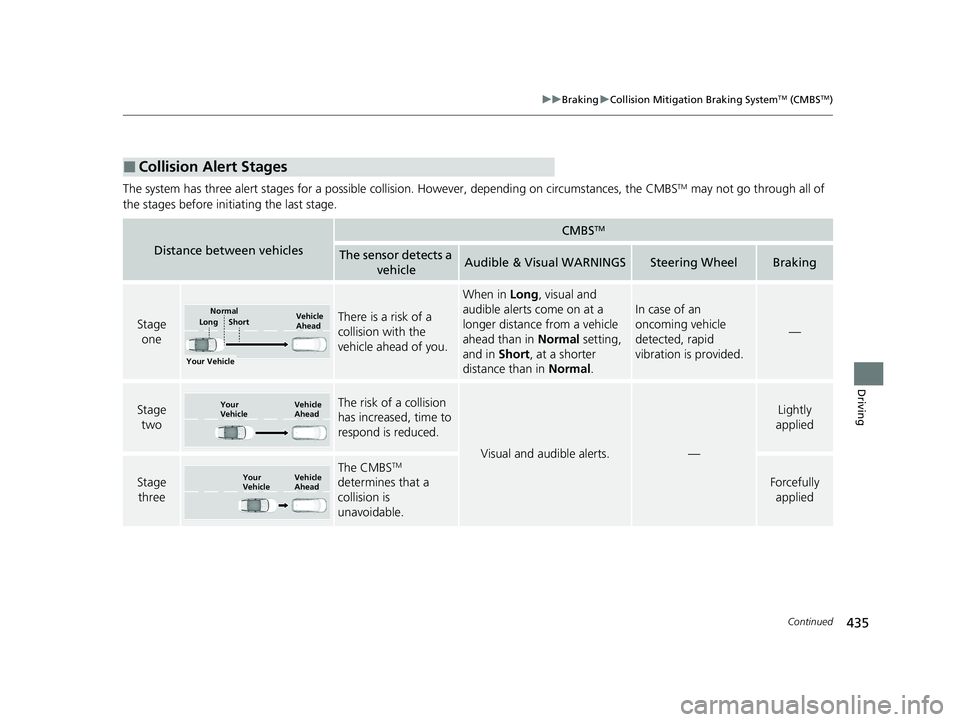
435
uuBraking uCollision Mitigation Braking SystemTM (CMBSTM)
Continued
Driving
The system has three alert stages for a possible collis ion. However, depending on circumstances, the CMBSTM may not go through all of
the stages before initiating the last stage.
■Collision Alert Stages
Distance between vehicles
CMBSTM
The sensor detects a vehicleAudible & Visual WARNINGSSteering WheelBraking
Stage oneThere is a risk of a
collision with the
vehicle ahead of you.
When in Long, visual and
audible alerts come on at a
longer distance from a vehicle
ahead than in Normal setting,
and in Short, at a shorter
distance than in Normal.
In case of an
oncoming vehicle
detected, rapid
vibration is provided.
—
Stage
twoThe risk of a collision
has increased, time to
respond is reduced.
Visual and audible alerts.—
Lightly
applied
Stage three
The CMBSTM
determines that a
collision is
unavoidable.
Forcefully
applied
Your Vehicle Vehicle
Ahead
Short
LongNormal
Your
Vehicle Vehicle
Ahead
Your
VehicleVehicle
Ahead
20 CLARITY FCV CSS-31TRT6300.book 435 ページ 2019年9月10日 火曜日 午前11
時3分
Page 439 of 551
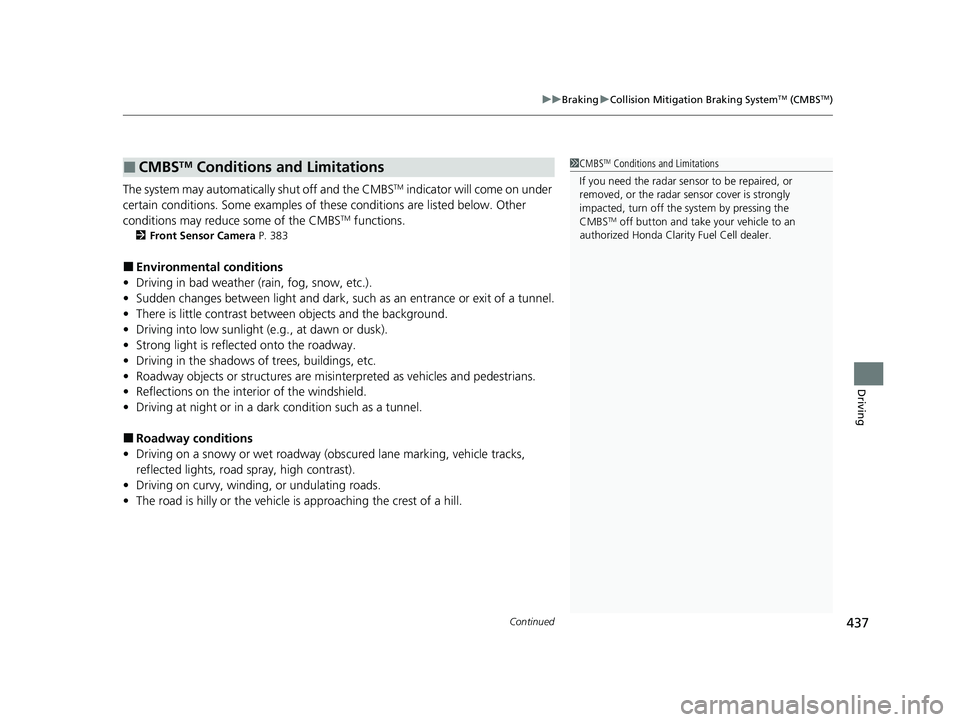
Continued437
uuBraking uCollision Mitigation Braking SystemTM (CMBSTM)
Driving
The system may automatically shut off and the CMBSTM indicator will come on under
certain conditions. Some examples of thes e conditions are listed below. Other
conditions may reduce some of the CMBS
TM functions.
2 Front Sensor Camera P. 383
■Environmental conditions
• Driving in bad weather (rain, fog, snow, etc.).
• Sudden changes between light and dark, such as an entrance or exit of a tunnel.
• There is little contrast between objects and the background.
• Driving into low sunlight (e.g., at dawn or dusk).
• Strong light is reflec ted onto the roadway.
• Driving in the shadows of trees, buildings, etc.
• Roadway objects or structures are misint erpreted as vehicles and pedestrians.
• Reflections on the interi or of the windshield.
• Driving at night or in a dark condition such as a tunnel.
■Roadway conditions
• Driving on a snowy or wet roadway (obs cured lane marking, vehicle tracks,
reflected lights, road spray, high contrast).
• Driving on curvy, winding, or undulating roads.
• The road is hilly or the vehicle is approaching the crest of a hill.
■CMBSTM Conditions and Limitations1CMBSTM Conditions and Limitations
If you need the radar sensor to be repaired, or
removed, or the radar se nsor cover is strongly
impacted, turn off the system by pressing the
CMBS
TM off button and take your vehicle to an
authorized Honda Clarit y Fuel Cell dealer.
20 CLARITY FCV CSS-31TRT6300.book 437 ページ 2019年9月10日 火曜日 午前11 時3分
Page 440 of 551
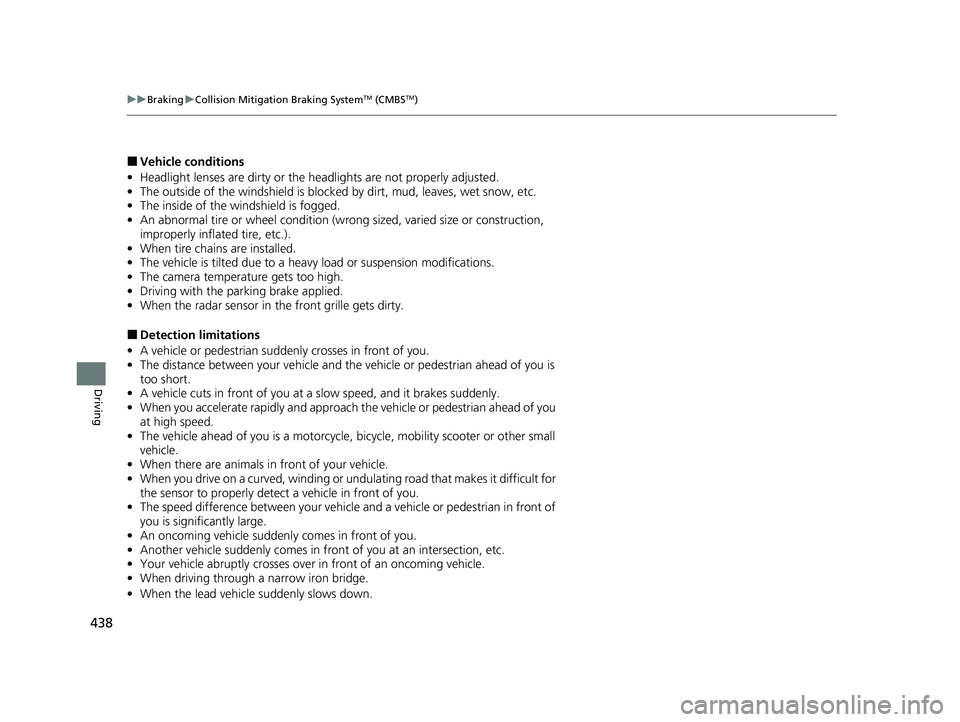
438
uuBraking uCollision Mitigation Braking SystemTM (CMBSTM)
Driving
■Vehicle conditions
• Headlight lenses are dirty or the headlights are not properly adjusted.
• The outside of the windshie ld is blocked by dirt, mud, leaves, wet snow, etc.
• The inside of the windshield is fogged.
• An abnormal tire or wheel condition (wrong sized, varied size or construction,
improperly inflated tire, etc.).
• When tire chains are installed.
• The vehicle is tilted due to a heav y load or suspension modifications.
• The camera temperature gets too high.
• Driving with the parking brake applied.
• When the radar sensor in the front grille gets dirty.
■Detection limitations
• A vehicle or pedestrian suddenly crosses in front of you.
• The distance between your vehicle and the vehicle or pedestrian ahead of you is
too short.
• A vehicle cuts in front of you at a slow speed, and it brakes suddenly.
• When you accelerate rapidly and approach the vehicle or pedestrian ahead of you
at high speed.
• The vehicle ahead of you is a motorcycle, bicycle, mobility scooter or other small
vehicle.
• When there are animals in front of your vehicle.
• When you drive on a curved, winding or undulating road that makes it difficult for
the sensor to properly detect a vehicle in front of you.
• The speed difference between your vehicle an d a vehicle or pedestrian in front of
you is significantly large.
• An oncoming vehicle suddenly comes in front of you.
• Another vehicle suddenly comes in front of you at an intersection, etc.
• Your vehicle abruptly crosses over in front of an oncoming vehicle.
• When driving through a narrow iron bridge.
• When the lead vehicle suddenly slows down.
20 CLARITY FCV CSS-31TRT6300.book 438 ページ 2019年9月10日 火曜日 午前11 時3分
Page 445 of 551
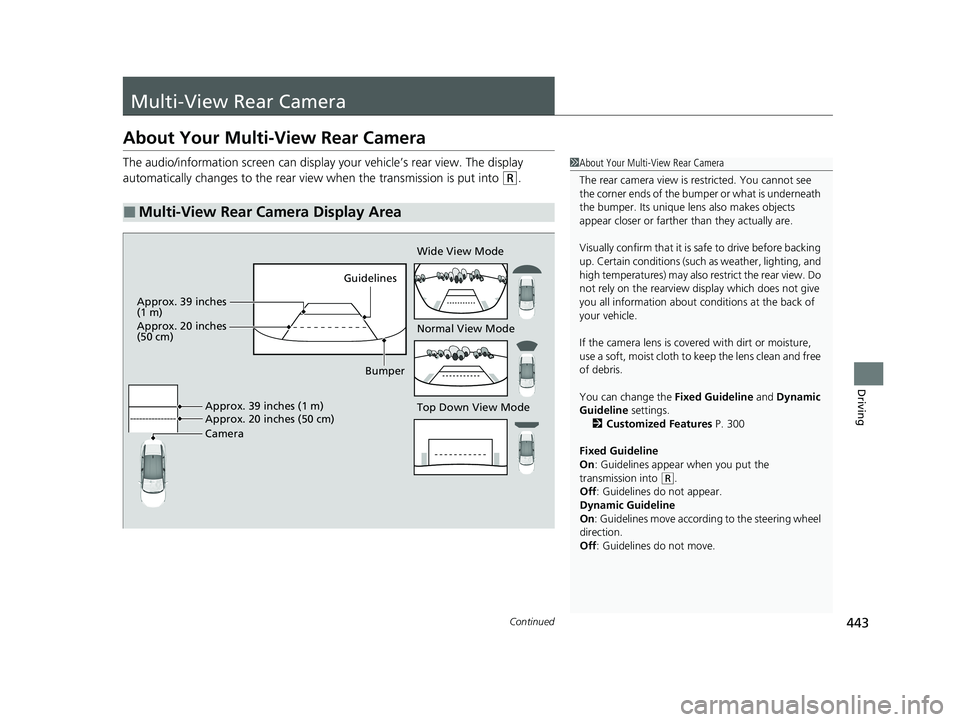
443Continued
Driving
Multi-View Rear Camera
About Your Multi-View Rear Camera
The audio/information screen can display your vehicle’s rear view. The display
automatically changes to the rear view when the transmission is put into
(R.
■Multi-View Rear Camera Display Area
1About Your Multi-View Rear Camera
The rear camera view is restricted. You cannot see
the corner ends of the bumper or what is underneath
the bumper. Its unique le ns also makes objects
appear closer or farther than they actually are.
Visually confirm that it is safe to drive before backing
up. Certain conditions (such as weather, lighting, and
high temperatures) may also restrict the rear view. Do
not rely on the rearview display which does not give
you all information about conditions at the back of
your vehicle.
If the camera lens is cove red with dirt or moisture,
use a soft, moist cloth to keep the lens clean and free
of debris.
You can change the Fixed Guideline and Dynamic
Guideline settings.
2 Customized Features P. 300
Fixed Guideline
On : Guidelines appear when you put the
transmission into
( R.
Off : Guidelines do not appear.
Dynamic Guideline
On : Guidelines move according to the steering wheel
direction.
Off : Guidelines do not move.
Top Down View Mode Normal View Mode Wide View Mode
Guidelines
Bumper
Camera Approx. 39 inches (1 m)
Approx. 20 inches (50 cm)
Approx. 39 inches
(1 m)
Approx. 20 inches
(50 cm)
20 CLARITY FCV CSS-31TRT6300.book 443 ページ 2019年9月10日 火曜日 午前11 時3分
Page 447 of 551
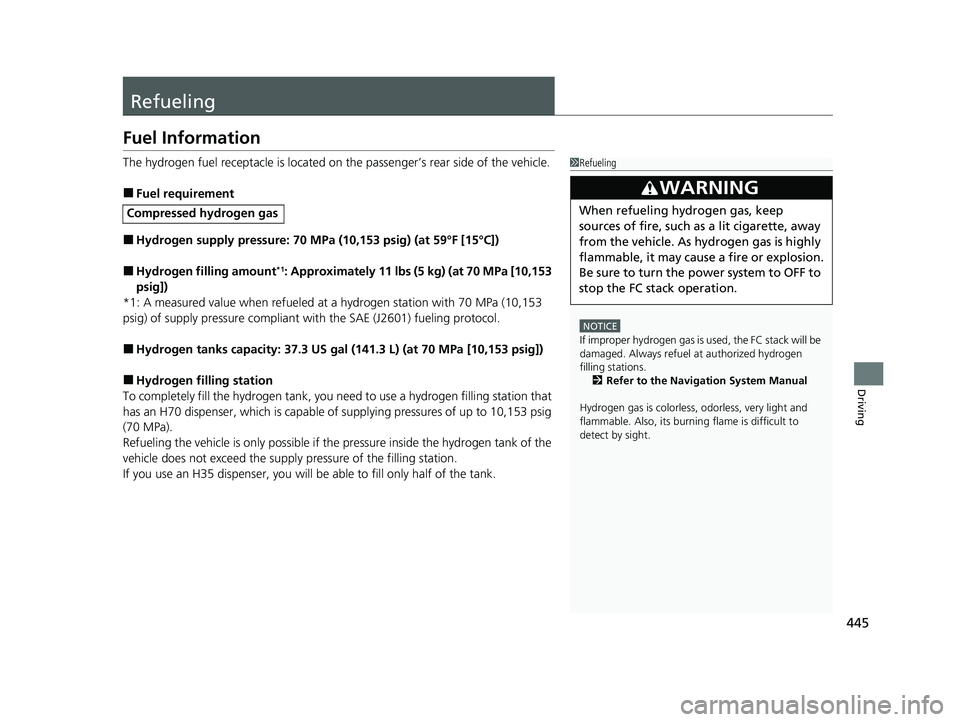
445
Driving
Refueling
Fuel Information
The hydrogen fuel receptacle is located on the passenger’s rear side of the vehicle.
■Fuel requirement
■Hydrogen supply pressure: 70 MPa (10,153 psig) (at 59°F [15°C])
■Hydrogen filling amount*1: Approximately 11 lbs (5 kg) (at 70 MPa [10,153
psig])
*1: A measured value when refueled at a hydrogen station with 70 MPa (10,153
psig) of supply pressure compliant with the SAE (J2601) fueling protocol.
■Hydrogen tanks capacity: 37.3 US gal (141.3 L) (at 70 MPa [10,153 psig])
■Hydrogen filling station
To completely fill the hydrogen tank, you ne ed to use a hydrogen filling station that
has an H70 dispenser, which is capable of supplying pressures of up to 10,153 psig
(70 MPa).
Refueling the vehicle is only possible if the pressure inside the hydrogen tank of the
vehicle does not exceed the supply pressure of the filling station.
If you use an H35 dispenser, you will be able to fill only half of the tank.
Compressed hydrogen gas
1 Refueling
NOTICE
If improper hydrogen gas is us ed, the FC stack will be
damaged. Always refuel at authorized hydrogen
filling stations.
2 Refer to the Navigation System Manual
Hydrogen gas is colorless, odorless, very light and
flammable. Also, its burni ng flame is difficult to
detect by sight.
3WARNING
When refueling hydrogen gas, keep
sources of fire, such as a lit cigarette, away
from the vehicle. As hydrogen gas is highly
flammable, it may caus e a fire or explosion.
Be sure to turn the po wer system to OFF to
stop the FC stack operation.
20 CLARITY FCV CSS-31TRT6300.book 445 ページ 2019年9月10日 火曜日 午前11 時3分
Page 451 of 551
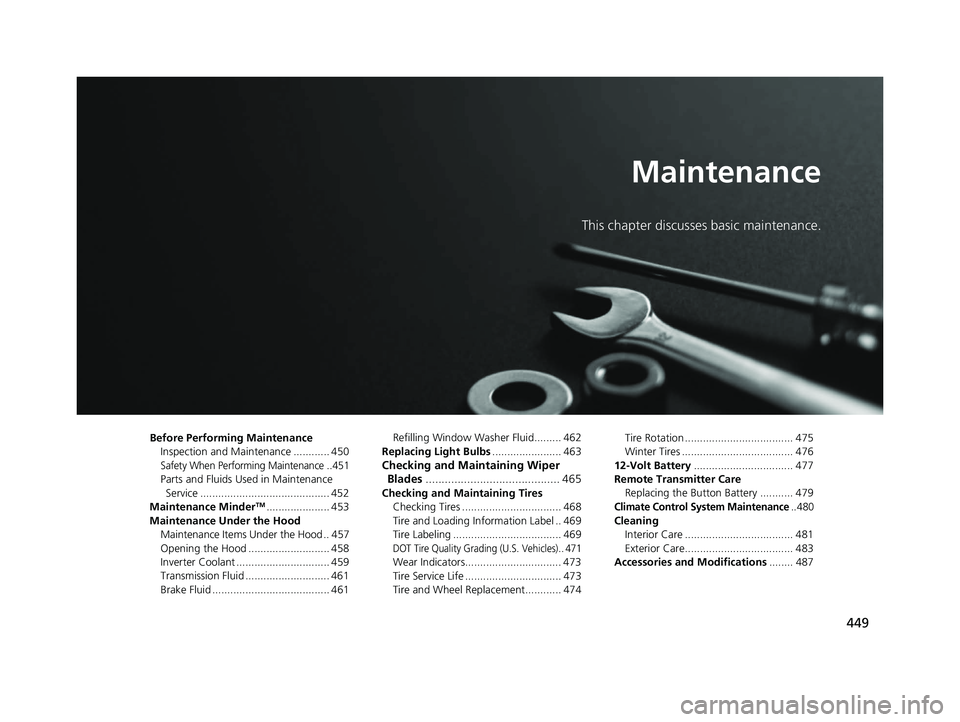
449
Maintenance
This chapter discusses basic maintenance.
Before Performing MaintenanceInspection and Maintenance ............ 450
Safety When Performing Maintenance ..451
Parts and Fluids Used in Maintenance Service ........................................... 452
Maintenance Minder
TM..................... 453
Maintenance Under the Hood Maintenance Items Under the Hood .. 457
Opening the Hood ........................... 458
Inverter Coolant ............................... 459
Transmission Fluid ............................ 461
Brake Fluid ....................................... 461 Refilling Window Washer Fluid......... 462
Replacing Light Bulbs ....................... 463
Checking and Maintaining Wiper
Blades .......................................... 465
Checking and Maintaining Tires
Checking Tires ................................. 468
Tire and Loading Information Label .. 469
Tire Labeling .................................... 469
DOT Tire Quality Grading (U.S. Vehicles).. 471
Wear Indicators................................ 473
Tire Service Life ................................ 473
Tire and Wheel Replacement............ 474 Tire Rotation .................................... 475
Winter Tires ..................................... 476
12-Volt Battery ................................. 477
Remote Transmitter Care Replacing the Button Battery ........... 479
Climate Control System Maintenance.. 480
CleaningInterior Care .................................... 481
Exterior Care.................................... 483
Accessories and Modifications ........ 487
20 CLARITY FCV CSS-31TRT6300.book 449 ページ 2019年9月10日 火曜日 午前11 時3分
Page 452 of 551
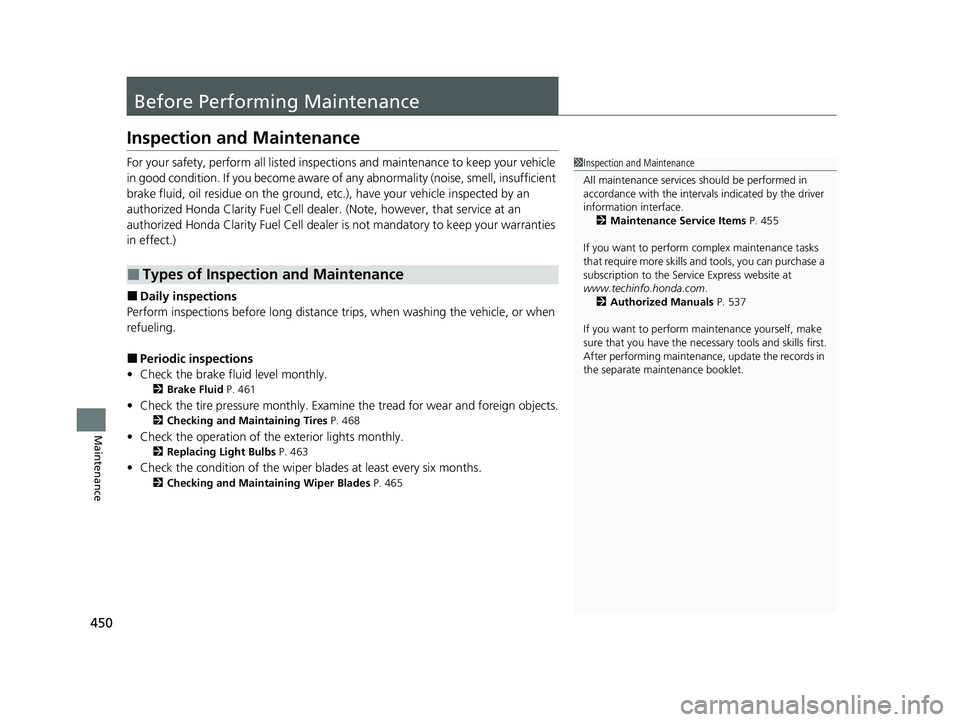
450
Maintenance
Before Performing Maintenance
Inspection and Maintenance
For your safety, perform all listed inspections and maintenance to keep your vehicle
in good condition. If you become aware of an y abnormality (noise, smell, insufficient
brake fluid, oil residue on the ground, etc .), have your vehicle inspected by an
authorized Honda Clar ity Fuel Cell dealer. (Note, however, that service at an
authorized Honda Clarity Fuel Cell dealer is not mandatory to keep your warranties
in effect.)
■Daily inspections
Perform inspections before long distance trips, when washing the vehicle, or when
refueling.
■Periodic inspections
• Check the brake fluid level monthly.
2 Brake Fluid P. 461
•Check the tire pressure monthly. Examin e the tread for wear and foreign objects.
2Checking and Maintaining Tires P. 468
•Check the operation of the exterior lights monthly.
2 Replacing Light Bulbs P. 463
•Check the condition of the wiper bl ades at least every six months.
2Checking and Maintaining Wiper Blades P. 465
■Types of Inspection and Maintenance
1Inspection and Maintenance
All maintenance services should be performed in
accordance with the intervals indicated by the driver
information interface. 2 Maintenance Service Items P. 455
If you want to perform complex maintenance tasks
that require more skills a nd tools, you can purchase a
subscription to the Service Express website at
www.techinfo.honda.com .
2 Authorized Manuals P. 537
If you want to perform ma intenance yourself, make
sure that you have the necessary tools and skills first.
After performing maintenanc e, update the records in
the separate maintenance booklet.
20 CLARITY FCV CSS-31TRT6300.book 450 ページ 2019年9月10日 火曜日 午前11 時3分
Page 460 of 551
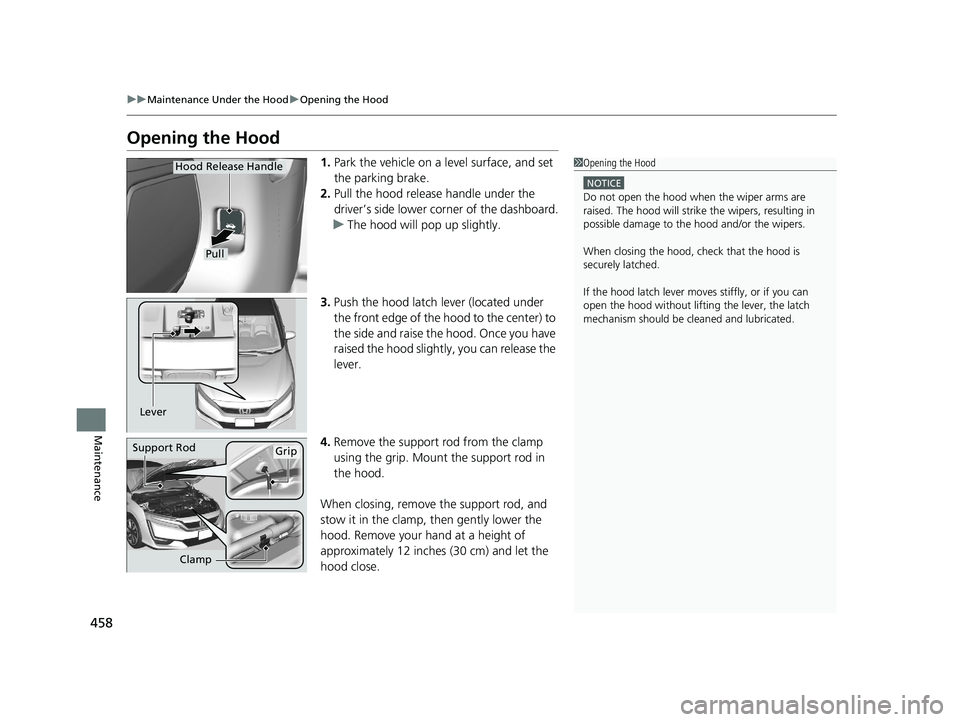
458
uuMaintenance Under the Hood uOpening the Hood
Maintenance
Opening the Hood
1. Park the vehicle on a level surface, and set
the parking brake.
2. Pull the hood release handle under the
driver’s side lower co rner of the dashboard.
u The hood will pop up slightly.
3. Push the hood latch lever (located under
the front edge of the hood to the center) to
the side and raise the hood. Once you have
raised the hood slightly, you can release the
lever.
4. Remove the support rod from the clamp
using the grip. Mount the support rod in
the hood.
When closing, remove the support rod, and
stow it in the clamp, then gently lower the
hood. Remove your hand at a height of
approximately 12 inches (30 cm) and let the
hood close.1 Opening the Hood
NOTICE
Do not open the hood when the wiper arms are
raised. The hood will strike the wipers, resulting in
possible damage to the hood and/or the wipers.
When closing the hood, check that the hood is
securely latched.
If the hood latch lever moves stiffly, or if you can
open the hood without lifti ng the lever, the latch
mechanism should be cl eaned and lubricated.
Pull
Hood Release Handle
Lever
Support RodGrip
Clamp
20 CLARITY FCV CSS-31TRT6300.book 458 ページ 2019年9月10日 火曜日 午前11 時3分